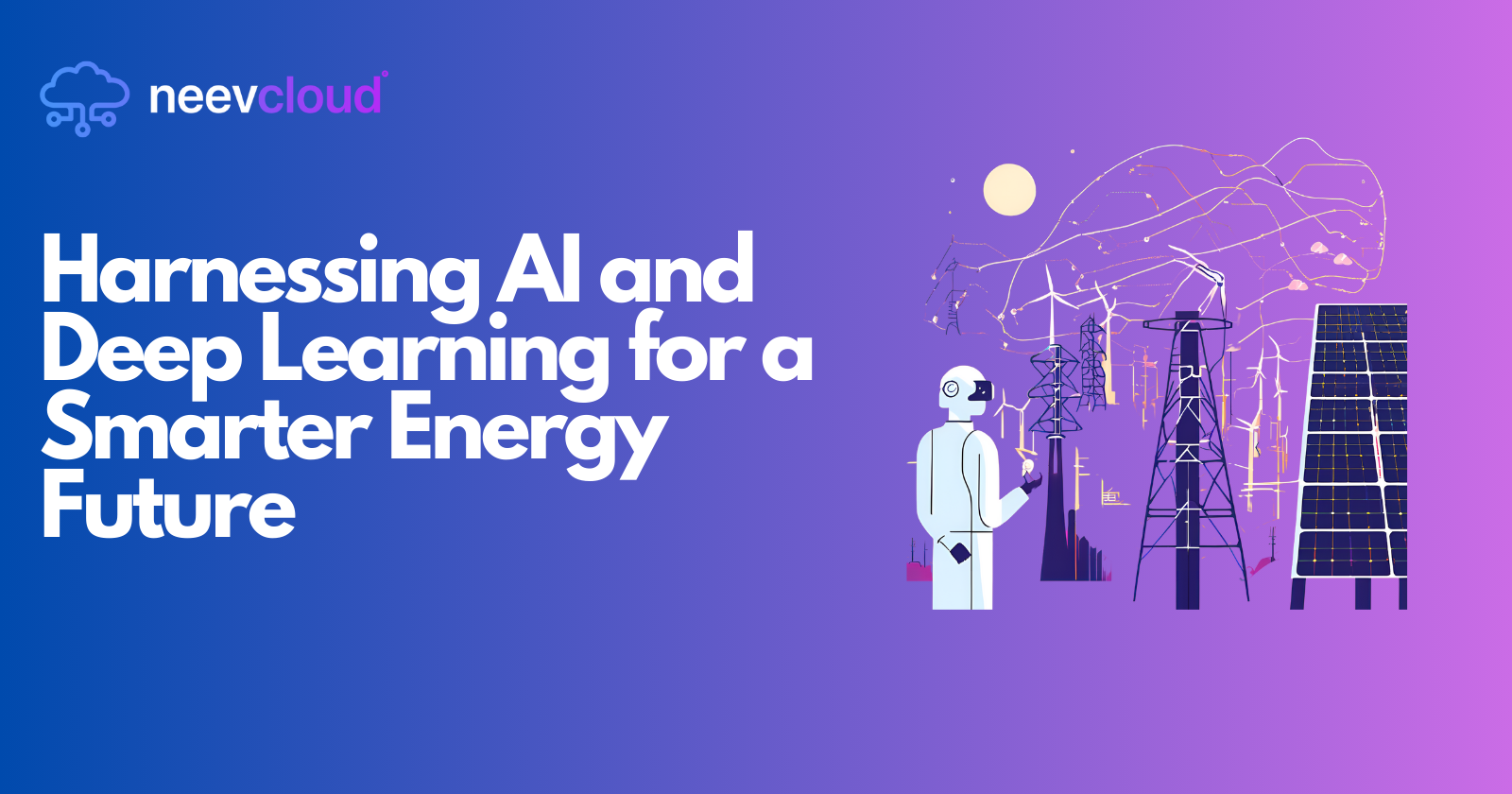Harnessing AI and Deep Learning for a Smarter Energy Future
 Tanvi Ausare
Tanvi Ausare
Artificial Intelligence (AI) and Deep Learning have become essential tools in transforming the global electricity landscape. With growing electricity demands, sustainability concerns, and distributed grids, traditional energy management systems struggle to keep up. However, advanced AI technologies—hosted on cloud platforms—offer innovative solutions that can optimize energy generation, consumption, and distribution. Platforms like AI Cloud, AI SuperCloud, and cloud for deep learning enable energy providers to adopt predictive and prescriptive analytics, ensuring greater efficiency. In this blog, we’ll explore how AI and deep learning are revolutionizing the electricity industry.
Introduction to AI and Deep Learning in Electricity
The energy sector is undergoing a digital transformation, moving from manual operations toward intelligent, automated systems. AI and deep learning play key roles in this transition by offering advanced tools for analyzing enormous data sets generated from smart meters, IoT sensors, weather models, and grid infrastructure. These insights improve forecasting, load balancing, and fault detection—leading to enhanced operational efficiency and sustainability.
AI in electricity enables real-time energy management through predictive analytics and decision-making algorithms.
Deep learning models—powered by neural networks—help identify complex patterns in vast datasets, driving more accurate forecasting and optimization.
Cloud platforms for AI and deep learning ensure scalability, reliability, and real-time access to computational resources.
Key Applications of Deep Learning in the Energy Sector
AI and deep learning technologies provide actionable insights across the electricity value chain, from production to consumption.
1. Demand Forecasting and Load Management
Accurate predictions of electricity consumption reduce energy wastage and prevent overproduction.
Deep learning models analyze historical usage patterns, weather data, and external factors to forecast demand in real time.
Utilities can implement dynamic load balancing based on AI-generated forecasts, optimizing energy distribution across grids.
2. Fault Detection and Predictive Maintenance
Deep learning algorithms continuously monitor power lines, transformers, and grid components for irregularities.
AI-powered systems perform predictive maintenance, identifying potential faults before they cause outages.
Cloud-based solutions enable remote diagnostics and real-time alerts for energy providers.
3. Energy Optimization for Smart Grids
AI-based smart grids use deep learning to optimize energy flow based on consumption patterns and grid conditions.
Utilities can integrate renewable sources such as solar and wind more efficiently by managing fluctuations using deep learning.
AI-enhanced microgrids provide localized energy solutions, improving grid reliability.
4. Renewable Energy Forecasting
Predicting the output of solar, wind, and hydropower requires advanced deep learning models that process weather forecasts, historical data, and environmental variables.
AI helps minimize the uncertainty in renewable energy supply, ensuring a smooth integration into the grid.
AI SuperCloud platforms facilitate large-scale simulations, enhancing renewable forecasting accuracy.
5. Smart Meter Analytics and Energy Theft Detection
AI-enabled smart meters collect granular consumption data, offering consumers detailed insights and recommendations for saving energy.
Deep learning algorithms detect anomalies and unauthorized consumption, helping utilities tackle electricity theft.
Cloud platforms enable the centralized processing of smart meter data, ensuring real-time monitoring.
Benefits of AI-Powered Electricity Systems
AI and deep learning offer numerous benefits that make electricity systems smarter, more sustainable, and cost-effective.
Operational Efficiency: Predictive maintenance and optimized load management minimize downtime and reduce operational costs.
Improved Customer Experience: AI-powered energy platforms offer personalized recommendations, energy-saving tips, and dynamic pricing.
Reduced Carbon Footprint: AI helps integrate renewables effectively, ensuring a sustainable energy future.
Real-time Decision-making: Cloud platforms facilitate real-time processing, improving grid stability and fault response.
Cost Optimization: Deep learning models ensure optimal energy generation and consumption, leading to financial savings for both providers and consumers.
Role of Cloud for Deep Learning in Electricity
Processing and storing massive amounts of data generated by energy grids, smart meters, and renewable sources require robust infrastructure. Cloud for deep learning provides the necessary computational resources and scalability to handle these workloads efficiently.
High-Performance Computing (HPC) on the cloud enables the training and deployment of complex deep learning models.
Cloud platforms provide scalability, allowing utilities to scale their resources based on demand spikes or seasonal variations.
AI SuperCloud solutions offer enhanced capabilities by aggregating multiple cloud resources into a unified platform, ideal for large-scale energy simulations.
Cloud providers offer managed AI services, simplifying model deployment, monitoring, and maintenance.
Why AI Cloud and AI SuperCloud Are Crucial for Energy Innovation
Both AI Cloud and AI SuperCloud play pivotal roles in enabling rapid innovation in the electricity industry by offering powerful infrastructure and services.
AI Cloud for Energy Providers
Fast Model Deployment: AI Cloud platforms allow for quick deployment of predictive models, ensuring real-time decision-making.
Data Security and Compliance: Utilities can rely on AI Cloud providers for secure data storage and compliance with regulatory standards.
Seamless Integration: AI Cloud services integrate with IoT devices, smart meters, and other components in the energy ecosystem.
AI SuperCloud for Large-Scale Simulations
High Computational Power: AI SuperCloud aggregates multiple cloud environments, providing immense computational power for energy simulations.
Collaborative Research: Universities, utilities, and governments can collaborate using shared AI SuperCloud infrastructure.
AI-Driven Energy Markets: SuperCloud enables dynamic energy trading platforms powered by deep learning algorithms.
Challenges and Future Trends
Despite the benefits, several challenges must be addressed to fully leverage AI and deep learning in the electricity sector.
Challenges
Data Quality Issues: Inconsistent or inaccurate data from sensors and smart meters can affect AI model performance.
High Computational Costs: Training deep learning models requires significant computational power, which can be expensive.
Integration Complexity: Merging legacy systems with AI-powered solutions involves technical challenges.
Cybersecurity Risks: As grids become more interconnected, they become more vulnerable to cyberattacks.
Future Trends
Federated Learning: AI models can be trained across multiple decentralized nodes, enhancing privacy and reducing data transfer.
Edge AI for Electricity: Running AI models at the edge (e.g., smart meters, IoT devices) reduces latency and enhances real-time decision-making.
AI-Powered Virtual Power Plants (VPPs): Aggregating distributed energy resources using AI will allow the creation of VPPs, improving grid stability.
Carbon-Aware Energy Systems: AI systems will incorporate carbon-intensity metrics to ensure energy is sourced sustainably.
Self-Healing Grids: AI will enable grids to automatically detect and fix faults, minimizing downtime and improving resilience.
Conclusion
AI and deep learning are transforming the electricity industry, making it more efficient, sustainable, and resilient. With AI Cloud, AI SuperCloud, and cloud platforms for deep learning, energy providers can achieve breakthroughs in demand forecasting, fault detection, and renewable integration. However, the journey is not without challenges—data quality, integration complexity, and cybersecurity risks must be managed. As AI technologies continue to evolve, the energy sector will witness smarter grids, real-time energy optimization, and greater reliance on renewable sources.
The future of electricity is AI-driven, cloud-powered, and sustainable—and with platforms like NeevCloud, organizations can harness the power of AI and deep learning to light the way forward.
Subscribe to my newsletter
Read articles from Tanvi Ausare directly inside your inbox. Subscribe to the newsletter, and don't miss out.
Written by
